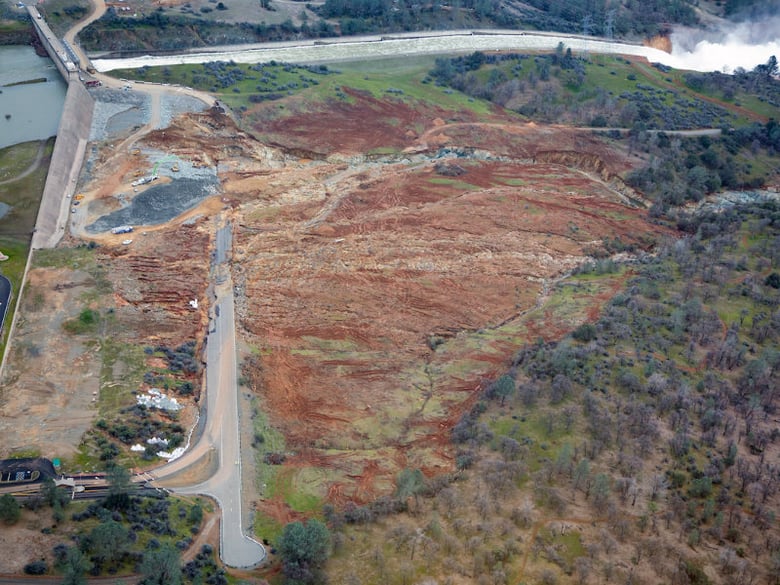Simulation Shows Oroville Dam Spillway Failure (original) (raw)
Update RequiredTo play audio, update browser or Flash plugin.

This aerial view looks over the eroded landscape just below the Oroville Dam Emergency Spillway. Photo taken February 15, 2017.
Dale Kolke / California Department of Water Resources
Water managers issued evacuation orders for nearly 200,000 Californians just hours before they thought an emergency spillway at Oroville dam could fail. Emergency officials said it would send a 30 foot wall of water downstream.
That might be hard to imagine, but a computer simulation by UC Santa Cruz research geophysicist Steven Ward shows flood waters would hit highway 70 in about 30 minutes. In less than three hours, it would hit Highway 99. After 9 hours, it would fan out to cover a 231-square mile area.
Ward says it would be a massive wave near Oroville. The videos of the main spillway releasing 100,000 cubic feet per second pale in comparison.
“We’ve seen all week the videos of the regular spillway operating at full speed at about 100,000 cubic feet per second. This partial break is about 20 times that. It’s going to overpower the dikes and levees for sure,” says Ward.
 
This simulation by Steven Ward, a UC Santa Cruz geophysicist, shows how fast and widespread flooding would be from an emergency spillway failure. The orange indicates water that empties from an area. Shades of blue represent the depth of the water, the lighter shades are at greater depths.
The most updated map above shows Oroville would receive water at depths of about 20 meters, or 65 feet. Biggs, Gridley, and Live Oak would also be inundated.
 
This is a 3-D version of the same simulation above. The simulation also shows the length of time it would take to cover an area.
Ward says such simulations can help emergency managers get a more accurate picture of where and when evacuations should occur.
“People die in evacuations from panic and heart attacks and car wrecks and everything so if you can limit the zone to one-half of what you called before, that would be a plus.”
 
Ward also simulated a full dam break at Oroville. In less than four hours, floodwaters would spread more than 380-square miles -- but that's only where the simulation stops, not the flood waters.
Follow us for more stories like this
CapRadio provides a trusted source of news because of you. As a nonprofit organization, donations from people like you sustain the journalism that allows us to discover stories that are important to our audience. If you believe in what we do and support our mission, please donate today.